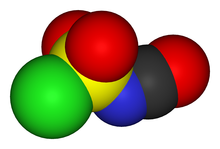Chlorosulfonyl isocyanate

| |

| |
| Names | |
|---|---|
| IUPAC name
Chlorosulfonyl isocyanate
| |
| Other names
N-Carbonylsulfamyl chloride
Chloropyrosulfonyl isocyanate Sulfuryl chloride isocyanate | |
| Identifiers | |
3D model (JSmol)
|
|
| ChemSpider | |
| EC Number |
|
PubChem CID
|
|
| UNII | |
| |
| |
| Properties | |
| CNClO3S | |
| Molar mass | 141.53 g/mol |
| Appearance | colorless liquid |
| Density | 1.626 g/cm3 |
| Melting point | −44 °C (−47 °F; 229 K) |
| Boiling point | 107 °C (225 °F; 380 K) |
| decomposition | |
| Solubility in other solvents | Chlorocarbons MeCN |
Refractive index (nD)
|
1.447 |
| Structure | |
| tetrahedral at S | |
| Hazards | |
| Occupational safety and health (OHS/OSH): | |
Main hazards
|
toxic, corrosive, flammable, reacts violently with water |
| GHS labelling: | |
   
| |
| Danger | |
| H302, H312, H314, H330, H332, H334 | |
| P260, P261, P264, P270, P271, P280, P284, P285, P301+P312, P301+P330+P331, P302+P352, P303+P361+P353, P304+P312, P304+P340, P304+P341, P305+P351+P338, P310, P312, P320, P321, P322, P330, P342+P311, P363, P403+P233, P405, P501 | |
| NFPA 704 (fire diamond) | <imagemap>
File:NFPA 704.svg|80px|alt=NFPA 704 four-colored diamond poly 150 150 300 300 150 450 0 300 Health 3: Short exposure could cause serious temporary or residual injury. E.g. chlorine gas poly 300 0 450 150 300 300 150 150 Flammability 1: Must be pre-heated before ignition can occur. Flash point over 93 °C (200 °F). E.g. canola oil poly 450 150 600 300 450 450 300 300 Instability 2: Undergoes violent chemical change at elevated temperatures and pressures, reacts violently with water, or may form explosive mixtures with water. E.g. white phosphorus poly 300 300 450 450 300 600 150 450 Special hazard W: Reacts with water in an unusual or dangerous manner. E.g. sodium, sulfuric acid desc none </imagemap> |
| Safety data sheet (SDS) | "External MSDS" |
| Related compounds | |
Related compounds
|
Thionyl chloride Cyanogen bromide Phosphoryl chloride |
Except where otherwise noted, data are given for materials in their standard state (at 25 °C [77 °F], 100 kPa).
| |
Chlorosulfonyl isocyanate is the chemical compound ClSO2NCO, known as CSI. This compound is a versatile reagent in organic synthesis.
Preparation, structure, handling
CSI is prepared by treating cyanogen chloride with sulfur trioxide, the product being distilled directly from the reaction mixture.[1]
- SO3 + ClCN → ClSO2NCO
In this transformation, both the carbon and the nitrogen termini of CN are functionalized.
The structure of CSI is represented as ClS(O)2-N=C=O. It consists of two electron-withdrawing components, the chlorosulfonyl group (SO2Cl) and the isocyanate group (-N=C=O). Because of its resulting electrophilicity, the use of CSI in chemical synthesis requires relatively inert solvents such as chlorocarbons, acetonitrile, and ethers.[2]
Uses
The molecule has two electrophilic sites, the carbon and the S(VI) center.[3]
CSI has been employed for the preparation of β-lactams,[4] some of which are medicinally important. Thus, alkenes undergo a [2+2]-cycloaddition to give the sulfonamide. The SO2Cl group can be removed simply by hydrolysis, leaving the secondary amide.[5] Other reactions of CSI:
- Cycloaddition to alkynes to give 1,2,3-oxathiazine-2,2-dioxide-6-chlorides.
- Conversion of primary alcohols to carbamates.[6]
- Conversion of carboxylic acids and the acid chlorides into nitriles.
- Preparation of N,N-disubstituted sulfamides, R2NSO2NH2
- Preparation of Burgess reagent
Safety considerations
CSI is toxic, corrosive and reacts violently with water.
References
- ^ Graf, R. "Chlorosulfonyl Isocyanate" Organic Syntheses, Collected Volume 5, pages 226ff.
- ^ Miller, M. J.; Ghosh, M.; Guzzo, P. R.; Vogt, P. F.; Hu, J.; Filzen, G. F.; Geyer, A. G. "Chlorosulfonyl Isocyanate" in "Encyclopedia of Reagents for Organic Synthesis" 2005 John Wiley & Sons: New York.
- ^ D. N. Dhar, K. S. K. Murthy "Recent Advances in the Chemistry of Chlorosulfonyl Isocyanate" Synthesis 1986; pages 437-449.
- ^ Kaur, Rajneesh; Singh, Raman; Kumar, Antresh; Kaur, Satvinder; Priyadarshi, Nitesh; Singhal, Nitin Kumar; Singh, Kuldeep (June 2020). "1,2,3-Triazole β-lactam conjugates as antimicrobial agents". Heliyon. 6 (6): e04241. doi:10.1016/j.heliyon.2020.e04241. PMC 7327255. PMID 32637684.
- ^ Cremlyn, R. J. “An Introduction to Organosulfur Chemistry” John Wiley and Sons: Chichester (1996). ISBN 0-471-95512-4
- ^ Burgess, E. M.; Penton, Jr., H. R.; Taylor, E. A.; Williams, W. M. "Conversion of Primary Alcohols to Urethanes via the Inner Salt of Triethylammonium Hydroxide: Methyl (Carboxylsulfamoyl) Triethylammonium Hydroxide Methyl n-Hexylcarbamate" Organic Syntheses, Coll. Vol. 6, p.788